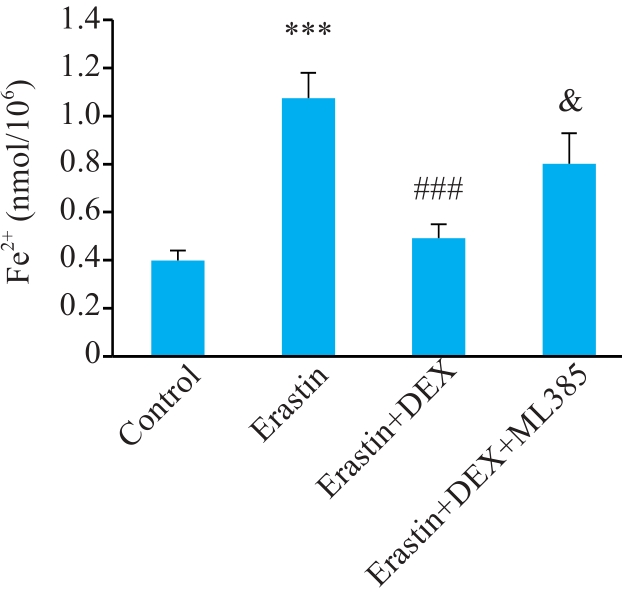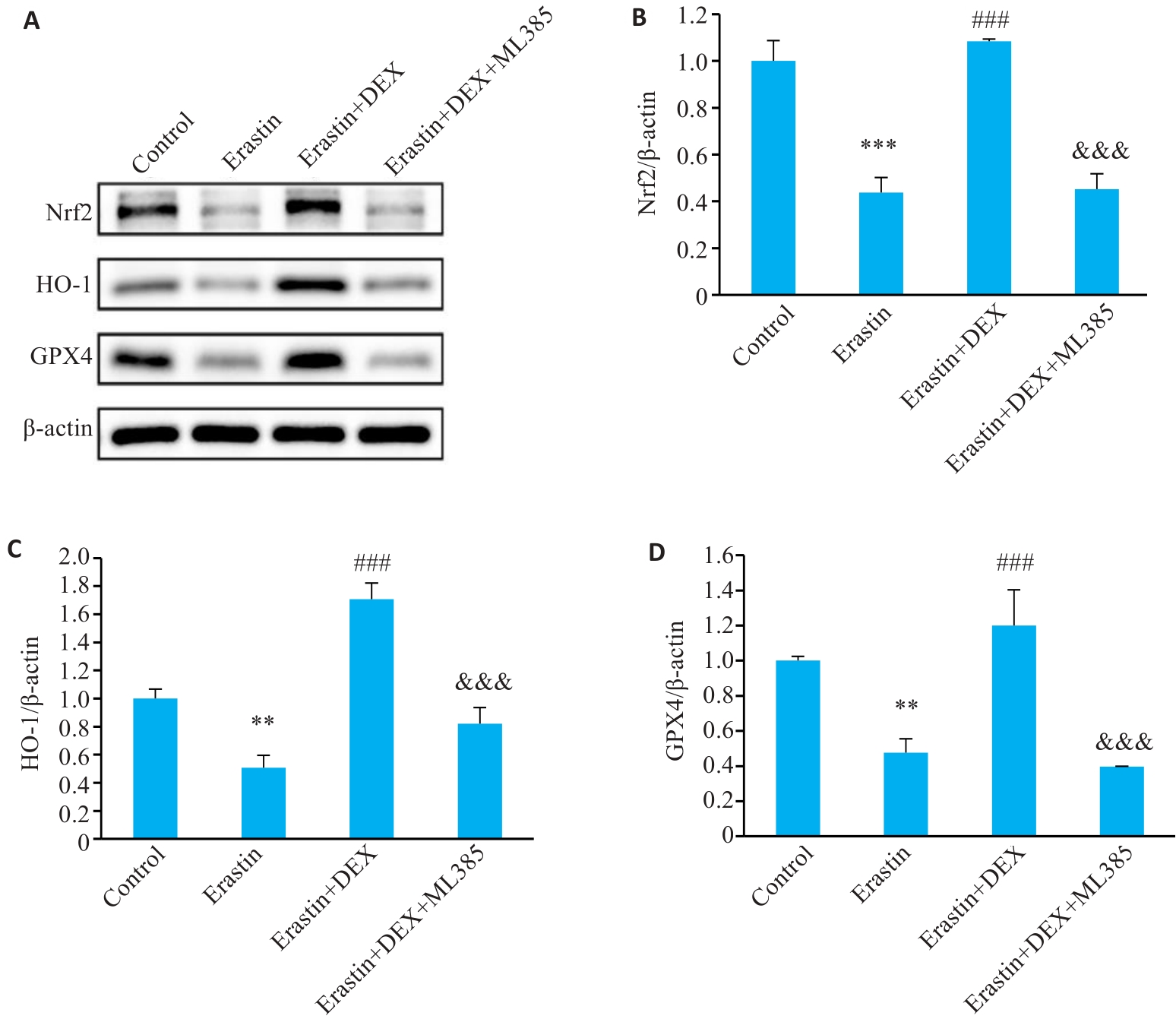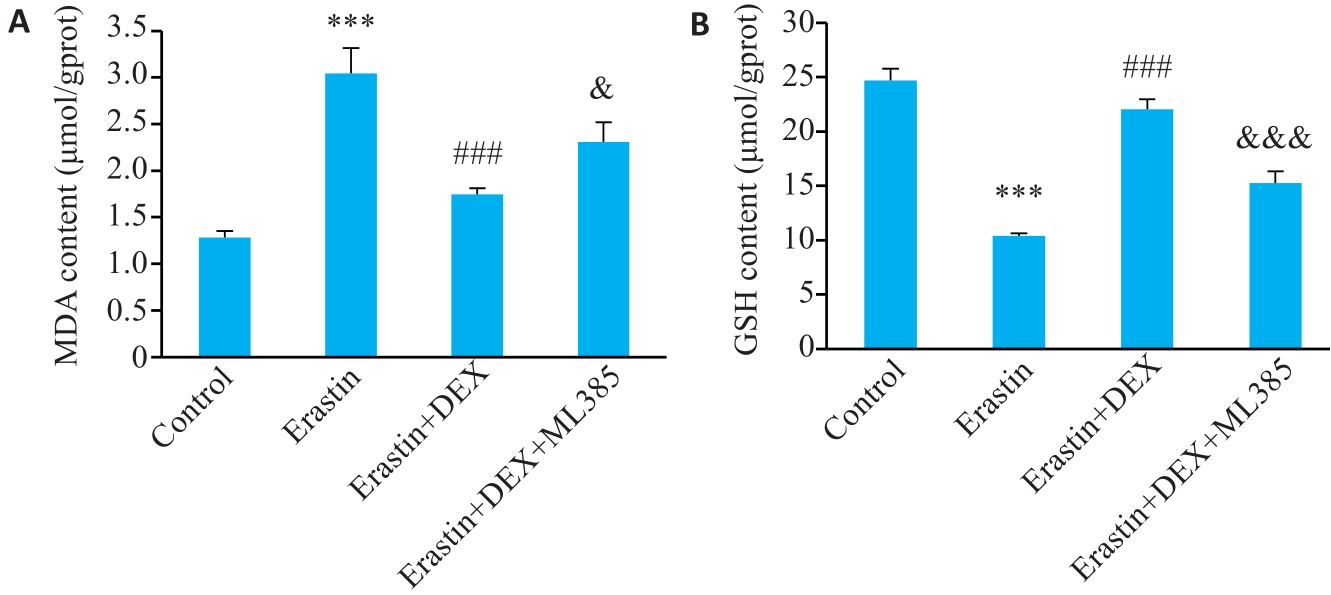Journal of Southern Medical University ›› 2024, Vol. 44 ›› Issue (6): 1135-1140.doi: 10.12122/j.issn.1673-4254.2024.06.14
Previous Articles Next Articles
Received:2023-11-29
Online:2024-06-20
Published:2024-07-01
Contact:
Gang LIU
E-mail:1176973799@qq.com;Liu_gang03@163.com
Fangyuan ZHANG, Gang LIU. Dexmedetomidine inhibits ferroptosis of human renal tubular epithelial cells by activating the Nrf2/HO-1/GPX4 pathway[J]. Journal of Southern Medical University, 2024, 44(6): 1135-1140.
Add to citation manager EndNote|Ris|BibTeX
URL: https://www.j-smu.com/EN/10.12122/j.issn.1673-4254.2024.06.14

Fig.1 Effect of DEX on viability of HK-2 cells treated with erastin (Mean±SD, n=3). A: Effects of different concentrations of erastin on viability of HK-2 cells. ***P<0.001 vs 0 μmol/L. B: DEX at different concentrations increases viability of erastin-treated HK-2 cells. C: ML385 attenuates the protective effect of DEX in erastin-treated HK-2 cells. ***P<0.001 vs Control group; #P<0.05, ###P<0.001 vs Erastin group; &&&P<0.001 vs Erastin+DEX group.

Fig.2 Effect of DEX on intracellular Fe2+ level in HK-2 cells treated with erastin (Mean±SD, n=3). ***P<0.001 vs Control group; ###P<0.001 vs Erastin group; &P<0.05 vs Erastin+DEX group.

Fig.3 Effect of DEX on protein expressions of Nrf2, HO-1 and GPX4 in HK-2 cells treated with erastin (Mean±SD, n=3). A: Western blotting results. B-D: Expression levels of Nrf2, HO-1 and GPX4 proteins in HK-2 cells with different treatments. **P<0.01, ***P<0.001 vs Control group; ###P<0.001 vs Erastin group; &&&P<0.001 vs Erastin+DEX group.

Fig.4 Effect of DEX on ROS level in HK-2 cells treated with erastin (Mean±SD, n=3). ***P<0.001 vs Control group; ###P<0.001 vs Erastin group; &&&P<0.001 vs Erastin+DEX group.

Fig.5 Effect of DEX on MDA and GSH contents in HK-2 cells treated with Erastin (Mean±SD, n=3). A: MDA content in HK-2 cells with different treatment. B: GSH content in HK-2 cells with different treatment. ***P<0.001 vs Control group; ###P<0.001 vs Erastin group; &P<0.05, &&&P<0.001 vs Erastin+DEX group.
| 1 | Zhang JS, Wang BQ, Yuan SZ, et al. The role of ferroptosis in acute kidney injury[J]. Front Mol Biosci, 2022, 9: 951275. |
| 2 | Thapa K, Singh TG, Kaur A. Targeting ferroptosis in ischemia/reperfusion renal injury[J]. Naunyn Schmiedebergs Arch Pharmacol, 2022, 395(11): 1331-41. |
| 3 | Wang Y, Bi R, Quan F, et al. Ferroptosis involves in renal tubular cell death in diabetic nephropathy[J]. Eur J Pharmacol, 2020, 888: 173574. |
| 4 | Zhuo WQ, Wen Y, Luo HJ, et al. Mechanisms of ferroptosis in chronic kidney disease[J]. Front Mol Biosci, 2022, 9: 975582. |
| 5 | Chen X, Li JB, Kang R, et al. Ferroptosis: machinery and regulation[J]. Autophagy, 2021, 17(9): 2054-81. |
| 6 | Rochette L, Dogon G, Rigal E, et al. Lipid peroxidation and iron metabolism: two corner stones in the homeostasis control of ferroptosis[J]. Int J Mol Sci, 2022, 24(1): 449. |
| 7 | Stockwell BR. Ferroptosis turns 10: emerging mechanisms, physiological functions, and therapeutic applications[J]. Cell, 2022, 185(14): 2401-21. |
| 8 | Jiang XJ, Stockwell BR, Conrad M. Ferroptosis: mechanisms, biology and role in disease[J]. Nat Rev Mol Cell Biol, 2021, 22(4): 266-82. |
| 9 | Dodson M, Castro-Portuguez R, Zhang DD. NRF2 plays a critical role in mitigating lipid peroxidation and ferroptosis[J]. Redox Biol, 2019, 23: 101107. |
| 10 | Yang WC, Wang YX, Zhang CG, et al. Maresin1 protect against ferroptosis-induced liver injury through ROS inhibition and Nrf2/HO-1/GPX4 activation[J]. Front Pharmacol, 2022, 13: 865689. |
| 11 | Zhang Y, Liu MM, Zhang YY, et al. Urolithin A alleviates acute kidney injury induced by renal ischemia reperfusion through the p62-Keap1-Nrf2 signaling pathway[J]. Phytother Res, 2022, 36(2): 984-95. |
| 12 | Zhao Y, Feng XJ, Li B, et al. Dexmedetomidine protects against lipopolysaccharide-induced acute kidney injury by enhancing autophagy through inhibition of the PI3K/AKT/mTOR pathway[J]. Front Pharmacol, 2020, 11: 128. |
| 13 | Shan XS, Zhang JX, Wei X, et al. Dexmedetomidine attenuates renal ischemia-reperfusion injury through activating PI3K/Akt-eNOS signaling via α2 adrenoreceptors in renal microvascular endothelial cells[J]. FASEB J, 2022, 36(11): e22608. |
| 14 | Song L, Feng SL, Yu H, et al. Dexmedetomidine protects against kidney fibrosis in diabetic mice by targeting miR-101-3p-mediated EndMT[J]. Dose Response, 2022, 20(1): 15593258221083486. |
| 15 | Wang Z, Wu JL, Hu ZL, et al. Dexmedetomidine alleviates lipopolysaccharide-induced acute kidney injury by inhibiting p75NTR-mediated oxidative stress and apoptosis[J]. Oxid Med Cell Longev, 2020, 2020: 5454210. |
| 16 | Feng Q, Yu XY, Qiao YJ, et al. Ferroptosis and acute kidney injury (AKI): molecular mechanisms and therapeutic potentials[J]. Front Pharmacol, 2022, 13: 858676. |
| 17 | Mengstie MA, Seid MA, Gebeyehu NA, et al. Ferroptosis in diabetic nephropathy: mechanisms and therapeutic implications[J]. Metabol Open, 2023, 18: 100243. |
| 18 | Zhou YJ, Zhang JL, Guan QY, et al. The role of ferroptosis in the development of acute and chronic kidney diseases[J]. J Cell Physiol, 2022, 237(12): 4412-27. |
| 19 | Zhai MY, Han MM, Huang X, et al. Dexmedetomidine protects human renal tubular epithelial HK-2 cells against hypoxia/reoxygenation injury by inactivating endoplasmic reticulum stress pathway[J]. Cell J, 2021, 23(4): 457-64. |
| 20 | Liu YT, Liu W, Wan ZH, et al. Protective effect of dexmedetomidine against renal injury in diabetic nephropathy rats through inhibiting NF‑κB pathway[J]. Eur Rev Med Pharmacol Sci, 2020, 24(22): 11865-70. |
| 21 | Tao WH, Shan XS, Zhang JX, et al. Dexmedetomidine attenuates ferroptosis-mediated renal ischemia/reperfusion injury and inflammation by inhibiting ACSL4 via α2-AR[J]. Front Pharmacol, 2022, 13: 782466. |
| 22 | Chen X, Comish PB, Tang DL, et al. Characteristics and biomarkers of ferroptosis[J]. Front Cell Dev Biol, 2021, 9: 637162. |
| 23 | Xie LH, Fefelova N, Pamarthi SH, et al. Molecular mechanisms of ferroptosis and relevance to cardiovascular disease[J]. Cells, 2022, 11(17): 2726. |
| 24 | Liu J, Kang R, Tang DL. Signaling pathways and defense mechanisms of ferroptosis[J]. FEBS J, 2022, 289(22): 7038-50. |
| 25 | Yan B, Ai YW, Sun Q, et al. Membrane damage during ferroptosis is caused by oxidation of phospholipids catalyzed by the oxidoreductases POR and CYB5R1[J]. Mol Cell, 2021, 81(2): 355-69. e10. |
| 26 | Chen YP, Feng XJ, Hu XY, et al. Dexmedetomidine ameliorates acute stress-induced kidney injury by attenuating oxidative stress and apoptosis through inhibition of the ROS/JNK signaling pathway[J]. Oxid Med Cell Longev, 2018, 2018: 4035310. |
| 27 | Adedoyin O, Boddu R, Traylor A, et al. Heme oxygenase-1 mitigates ferroptosis in renal proximal tubule cells[J]. Am J Physiol Renal Physiol, 2018, 314(5): F702-14. |
| 28 | 黄庆洋, 纪东东, 田绣云, 等. 小檗碱通过激活Nrf2-HO-1/GPX4通路抑制小鼠海马神经元HT22细胞的铁死亡[J]. 南方医科大学学报, 2022, 42(6): 937-43. |
| 29 | Li SW, Zheng LS, Zhang J, et al. Inhibition of ferroptosis by up-regulating Nrf2 delayed the progression of diabetic nephropathy[J]. Free Radic Biol Med, 2021, 162: 435-49. |
| 30 | Li X, Zou Y, Xing J, et al. Pretreatment with roxadustat (FG-4592) attenuates folic acid-induced kidney injury through antiferroptosis via akt/GSK-3β/Nrf2 pathway[J]. Oxid Med Cell Longev, 2020, 2020: 6286984. |
| 31 | Meng XY, Huang WJ, Mo WW, et al. ADAMTS-13-regulated nuclear factor E2-related factor 2 signaling inhibits ferroptosis to ameliorate cisplatin-induced acute kidney injuy[J]. Bioengineered, 2021, 12(2): 11610-21. |
| [1] | Xinyuan CHEN, Chengting WU, Ruidi LI, Xueqin PAN, Yaodan ZHANG, Junyu TAO, Caizhi LIN. Shuangshu Decoction inhibits growth of gastric cancer cell xenografts by promoting cell ferroptosis via the P53/SLC7A11/GPX4 axis [J]. Journal of Southern Medical University, 2025, 45(7): 1363-1371. |
| [2] | Mengying ZHANG, Chenling ZHAO, Liwei TIAN, Guofang YU, Wenming YANG, Ting DONG. Gandou Fumu Decoction improves liver steatosis by inhibiting hepatocyte ferroptosis in mice with Wilson's disease through the GPX4/ACSL4/ALOX15 signaling pathway [J]. Journal of Southern Medical University, 2025, 45(7): 1471-1478. |
| [3] | Anbang ZHANG, Xiuqi SUN, Bo PANG, Yuanhua WU, Jingyu SHI, Ning ZHANG, Tao YE. Electroacupuncture pretreatment alleviates cerebral ischemia-reperfusion injury in rats by inhibiting ferroptosis through the gut-brain axis and the Nrf2/HO-1 signaling pathway [J]. Journal of Southern Medical University, 2025, 45(5): 911-920. |
| [4] | Linluo ZHANG, Changqing LI, Lingling HUANG, Xueping ZHOU, Yuanyuan LOU. Catalpol reduces liver toxicity of triptolide in mice by inhibiting hepatocyte ferroptosis through the SLC7A11/GPX4 pathway: testing the Fuzheng Zhidu theory for detoxification [J]. Journal of Southern Medical University, 2025, 45(4): 810-818. |
| [5] | Yang LIU, Yiqing JIA, Chengcheng LI, Handing MAO, Shuyuan LIU, Yi SHAN. Dexmedetomidine attenuates heat stress-induced oncosis in human skeletal muscle cells by activating the Nrf2/Ho-1 pathway [J]. Journal of Southern Medical University, 2025, 45(3): 603-613. |
| [6] | Chunfei JI, Zongchao ZUO, Jun WANG, Miaonan LI. N-acetylneuraminic acid promotes ferroptosis of H9C2 cardiomyocytes with hypoxia/reoxygenation injury by inhibiting the Nrf2 axis [J]. Journal of Southern Medical University, 2025, 45(1): 72-79. |
| [7] | Shafa Amir, Montasery Mohammad, Shahhosseini Sedighe, Keivanfar Majid, Mehr Asieh Maghami, Babaei Mahtab Ebrahim, Jafari Mohammad. Original ArticleRespiratory complications of propofol, sevoflurane, and dexmedetomidine anesthesia for fiberoptic bronchoscopy in children aged 1 month to 3 years: a randomized trial [J]. Journal of Southern Medical University, 2024, 44(9): 1631-1636. |
| [8] | Kai CHEN, Zhaofei MENG, Jingting MIN, Jiahui WANG, Zhenghong LI, Qin GAO, Junfeng HU. Curcumin alleviates septic lung injury in mice by inhibiting TXNIP/TRX-1/GPX4-mediated ferroptosis [J]. Journal of Southern Medical University, 2024, 44(9): 1805-1813. |
| [9] | Mingzi OUYANG, Jiaqi CUI, Hui WANG, Zheng LIANG, Dajin PI, Liguo CHEN, Qianjun CHEN, Yingchao WU. Kaixinsan alleviates adriamycin-induced depression-like behaviors in mice by reducing ferroptosis in the prefrontal cortex [J]. Journal of Southern Medical University, 2024, 44(8): 1441-1449. |
| [10] | Yinliang ZHANG, Zetan LUO, Rui ZHAO, Na ZHAO, Zhidong XU, Di AO, Guyi CONG, Xinyu LIU, Hailun ZHENG. Sanguinarine induces ferroptosis of colorectal cancer cells by upregulating STUB1 and downregulating GPX4 [J]. Journal of Southern Medical University, 2024, 44(8): 1537-1544. |
| [11] | Yuanguo WANG, Peng ZHANG. Ferroptosis suppressor genes are highly expressed in esophageal cancer to inhibit tumor cell ferroptosis [J]. Journal of Southern Medical University, 2024, 44(7): 1389-1396. |
| [12] | Huaxing HE, Lulin LIU, Yingyin LIU, Nachuan CHEN, Suxia SUN. Sodium butyrate and sorafenib synergistically inhibit hepatocellular carcinoma cells possibly by inducing ferroptosis through inhibiting YAP [J]. Journal of Southern Medical University, 2024, 44(7): 1425-1430. |
| [13] | Zhixian REN, Beixian ZHOU, Linxin WANG, Jing LI, Rongping ZHANG, Xiping PAN. Inhibitory effect of 5-hydroxy-6,7-dimethoxyflavone on H1N1 influenza virus-induced ferroptosis and inflammation in A549 cells and its possible mechanisms [J]. Journal of Southern Medical University, 2024, 44(6): 1070-1078. |
| [14] | Nan WANG, Bin SHI, Xiaolan MAN, Weichao WU, Jia CAO. High expression of fragile X mental retardation protein inhibits ferroptosis of colorectal tumor cells by activating the RAS/MAPK signaling pathway [J]. Journal of Southern Medical University, 2024, 44(5): 885-893. |
| [15] | LI Shuxian, YU Shuping, MU Yaming, WANG Kai, LIU Yu, ZHANG Meihua. Metformin ameliorates PM2.5- induced functional impairment of placental trophoblasts by inhibiting ferroptosis [J]. Journal of Southern Medical University, 2024, 44(3): 437-446. |
| Viewed | ||||||
|
Full text |
|
|||||
|
Abstract |
|
|||||
